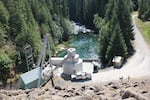
Undated photo of the Carmen-Smith Hydroelectric Project, located 70 miles east of Eugene on the upper McKenzie River. The project is EWEB's largest utility-owned power source and has served Eugene since 1963.
Courtesy of Eugene Water and Electric Board
The Eugene Water and Electric Board has approved an additional $3.3 million for fish passages at the Carmen-Smith Hydro Electric project along the McKenzie River about 70 miles east of Eugene.
The additional funds — an amendment to the utility’s contract with an engineering company — bring the total design and planning costs for the fish passage, and some other nearby fish-related projects, to $18.3 million.
For over a decade, the public utility has been required to build a fish passage to comply with licensing requirements. This project is a trap-and-haul design — which is when fish are trapped and then driven around the dam in a vehicle.
EWEB Generation Manager Lisa Krentz told the board the delays and increased costs were caused by sinkholes and seismic improvements.
She said the utility also had to proceed with its existing trap-and-haul plan it agreed to when it received its current license in 2019.
“We are under a compliance obligation to move forward with that until or unless we get a mandate to do something different we have to continue,” Krentz said.
The board unanimously approved the funds with one board member, Tim Morris, expressing concerns about a recent lawsuit over EWEB’s impact on endangered species, and the fallout of an unpredictable Trump administration.
“I know affordability is the number-one thing that our customers are looking for and if we’re continuing to invest in this project and it does make a sharp left, that’s a concern of mine,” Morris said.
EWEB General Manager Frank Lawson acknowledged the utility might lose money if it has to change plans, but said it could lose more if it runs afoul of regulators.
“The risk is incredibly high if we don’t adhere to the obligation of the existing license in whatever expeditious way we can demonstrate,” Lawson said.
Board member John Brown, who has been an EWEB Commissioner since 2007, said after repeated delays, he felt the utility didn’t have a choice but to continue on its current path.
“I’d love to save money too, but in my opinion this is necessary. We have to do this,” Brown said.
Bethany Cotton, conservation director for Cascadia Wildlands, which was one of the environmental groups that recently sued EWEB, said she was disappointed the utility was continuing its plans to trap and haul fish instead of studying the cost of a fish ladder.
Cotton argued a fish ladder is likely safer, and more effective during the overlapping spawning and wildfire seasons. She said previous wildfires that closed Highway 126 had already interfered with EWEB’s temporary trap-and-haul efforts.
“What happens when the roads are closed during spawning season and they can’t put the fish in a truck and drive them around the dam?” Cotton said.
Pending regulatory changes, construction on the permanent trap-and-haul facility is scheduled to begin in 2026.
Rebecca Hansen-White is a reporter with KLCC. This story comes to you from the Northwest News Network, a collaboration between public media organizations in Oregon and Washington.
It is part of OPB’s broader effort to ensure that everyone in our region has access to quality journalism that informs, entertains and enriches their lives. To learn more, visit our journalism partnerships page.
